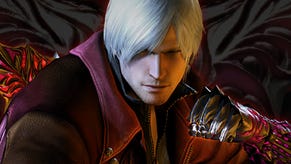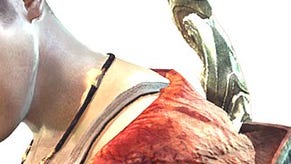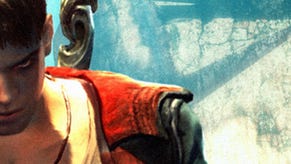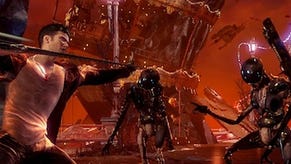DmC - expectation can be a double-edged sword
With DmC's first reviews now live, Stace Harman plays the first ten levels and finds that while sticks and stones might break his bones, Dante’s still a smart-arse.
Here is a title that rewards investment; Ninja Theory’s tacit acknowledgement is that when it comes to Dante, once is never enough.
Playing on medium difficulty, I reached the tenth of DmC’s 20-level campaign before dying for the first time.
Now, perhaps you believe that the implications of this admission encapsulate your expectations for Ninja Theory’s reboot. However, consider two things: the first is that a game over screen is seldom a prerequisite for an enjoyable experience. The second is that you’re not the only one with preconceived ideas concerning Dante’s return. Based on the first ten levels of DmC, it appears the Cambridge-based team responsible for this reboot has a few expectations of its own.
Ninja Theory’s first and most fundamental expectation is that it won’t only be veteran Devil May Cry players that play DmC. The Devil May Cry fan club is not an exclusive clique and you do not need to have played the previous games in the series in order to get a great deal from Dante’s fifth outing.
For first timers and those whose muscle-memory may have atrophied, DmC should be attempted on either Human or Devil Hunter difficulty levels. This will provide a comfortable challenge and allow you to master a handful of multi-hit combos and enjoy DmC’s modern-day narrative.
It’s fair to say that the series’s narrative history under Capcom has been filled with cheesy one-liners and pantomime performances. However, Ninja Theory excels at producing tightly-directed and well-acted stories and it set a high standard for performance capture in Enslaved: Odyssey to the West.
Granted, there’s still a generous handful of gorgonzola smothering DmC’s script, but while character development does not match that of Enslaved, it does produce a number of scenes that feature excellent performances from its cast.
The subtleties of facial expressions and body language enliven its cut-scenes, while the emphatic delivery of even some of its most outrageous lines can provoke a laugh. It’s an interesting story of revenge, betrayal and the insidious demon presence that has permeated every level of society.
Do not disturb
What’s more, some of its most disturbing scenes are sufficiently graphic to elicit a wince or exclamation of disgust; post-DmC, you’ll be less excited by the prospect of a “secret ingredient” in your favourite tasty junk food.
Ninja Theory might have developed DmC to be accessible by everyone, but the developer’s expectation of how seasoned players will approach it looks to be all together more hardcore. It appears to be taken as read that series veterans are going to want to replay both individual levels and the entire game multiple times.
This is evinced in level design that rewards those who revisit earlier stages armed with new weapons and techniques. Areas that were previously inaccessible can be plundered for hidden secrets, items and bonus stages. Meanwhile, the assumption that you’ll want to play through multiple times is most clearly demonstrated by the game’s seven modes and difficulty levels.
I wouldn’t usually spend time listing difficulty levels, but for an important sub-section of DmC’s players this is going to be a key feature, so: Human, Devil Hunter and Nephilim are available from the off and represent the traditional notion of Easy, Normal and Hard. However, with this being a Devil May Cry title, difficulty is more subjective than usual. Nephilim’s description reads: “Enemies are stronger and more challenging. Select this difficulty if you’ve played DmC before and want the full DmC experience.” In other words, veteran players should start here.
Complete the game on any of these three levels to unlock Son of Sparda, which introduces stronger enemies and remixed enemy waves. Complete Son of Sparda and you unlock both Dante Must Die and Heaven or Hell modes. Dante Must Die features the strongest and most extreme waves of enemies, while Heaven or Hell features the added twist of one-hit kills all round. Finally, complete the game on Heaven or Hell mode to gain access to the purist/sadist’s ultimate challenge: Heaven and Hell, in which Dante dies from any one hit, while enemies have full health.
Irrespective of whether you’re an old or new player and what difficulty level you select, Ninja Theory looks to have one final expectation of all of its players: that when it comes to a measure of progress, the positive reinforcement of a multi-faceted score system is universally preferred to the punitive punishment of death.
Points are awarded for style, which takes into account combo variety and is boosted by parrying enemy attacks, last minute evades and killing streaks. Taking damage drops the combat grade significantly and, as winners don’t do drugs, you’re also penalised for using healing items. End of level multipliers are added for the level completion percentage and the length of time taken and a rank from D to SSS is attributed. You might not die too often, but will you be satisfied until you’ve achieved at least an S rank on every level?
Dante has some neat new traversal moves (combining grapple and glide techniques that make me wonder what Ninja Theory could achieve with a Spider-Man licence) but as has long been the case with the series, the combat is the star of the show. His initial weapon-set consists of his sword, Rebellion, and quick firing twin pistols Ebony and Ivory. In the first half of the game, this load-out is bolstered by a handful of additional weapons that bring with them additional abilities, open up new areas and increase the potential for diverse combos.
The pre-defined combos are impressive, but skilled players will delight in creating their own based on each weapon’s unlockable and upgradeable move-set. The potential for seamlessly brutal self-expression is aided by telltale visual cues that can be used to link multiple moves from Dante’s entire arsenal, both on the ground and in the air.
Franchise fans have been vocal about their hopes and fears concerning this reboot, but it seems that the DmC developer also has expectations of its own. For the novice player, Ninja Theory has created an experience that rewards the gradual comprehension and increasingly competent execution of the game’s core mechanics.
However, it’s the game elements that require multiple play-throughs that should serve as a declaration of intent to the experienced anarchist. Here is a title that rewards investment; Ninja Theory’s tacit acknowledgement is that when it comes to Dante, once is never enough.
DmC: Devil May Cry releases on January 15 in the US and Europe.











